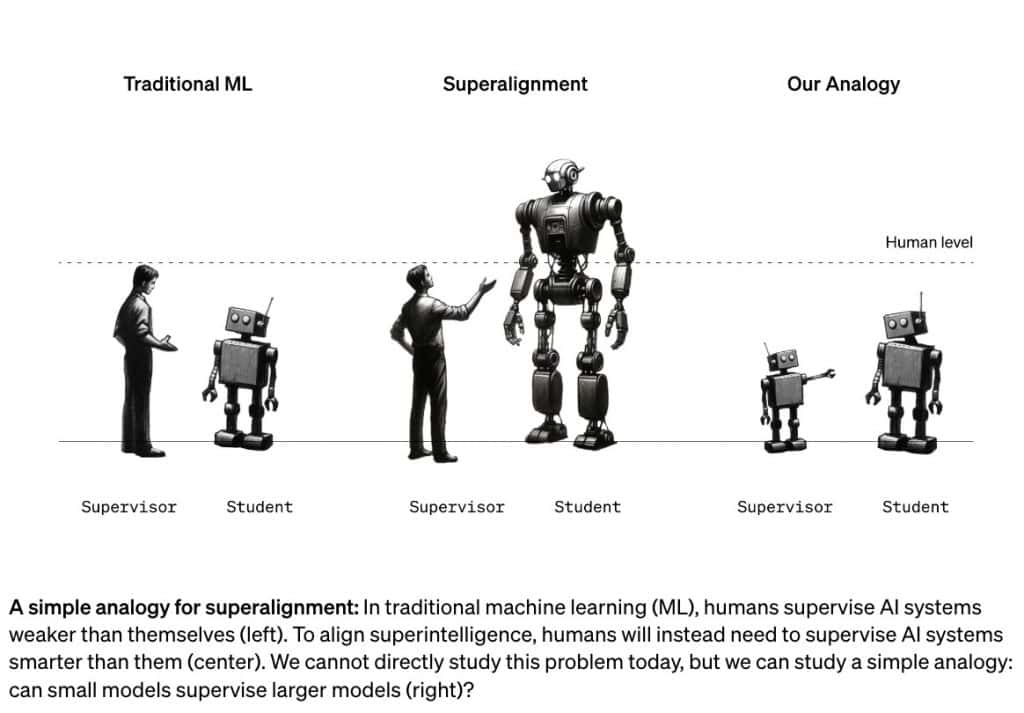[ad_1]


In Brief
OpenAI’s Superalignment team published the new research paper that promises a potential simplification of supervising highly advanced AI systems for people in the future.

The artificial intelligence (AI) research organization OpenAI’s Superalignment team published a new research paper introducing the concept of utilizing smaller AI models to supervise more advanced ones. This approach demonstrates impressive outcomes, promising a potential simplification of supervising highly advanced AI systems for people in the future.
In conventional machine learning, humans oversee AI systems less intelligent than themselves. However, with superintelligent AI, humans will need to supervise systems more intelligent than themselves.
In the pursuit of guiding and controlling superintelligent AI systems, researchers proposed a method where a less powerful AI model could supervise a more powerful one.

Ordinarily, it is unlikely for a strong model to outperform a weak supervisor, but strong pretrained models possess excellent capabilities. Researchers applied this approach by supervising GPT-4 with a GPT-2-level model. The resulting model is typically performed between GPT-3 and GPT-3.5, indicating it can achieve strong AI capabilities with weaker supervision.
Overall, the results suggest that while basic human supervision might not scale well to superintelligent models, there are ways to significantly enhance how well these models learn from less capable supervisors.
The researchers believe their approach captures essential difficulties in aligning future superhuman models, enabling them to make progress.
Alongside announcing research findings, OpenAI encouraged students, academics and other researchers to contribute to the broad field of superhuman AI alignment. The company launched a $10 million grant program focused on this problem.
OpenAI Advances Evolving Landscape of AI
According to OpenAI, superintelligent AI models exceeding human capabilities might be developed within the next decade. However, managing and directing these sophisticated AI systems pose a considerable challenge for people.
Existing alignment methods, such as reinforcement learning from human feedback (RLHF), depend on human guidance. However, future AI systems will be capable of extremely complex and creative behaviors that will make it hard for humans to reliably supervise them. Thus, the company is actively exploring innovative solutions to address the evolving landscape of AI development.
Recently, OpenAI allegedly announced the release of the company’s latest development – the GPT-4.5 model. The alleged screenshot suggested advanced capabilities encompassing language, audio, vision, video, 3D, complex reasoning, and cross-model understanding. However, Sam Altman, the founder of OpenAI, denied the rumors.
Disclaimer
In line with the Trust Project guidelines, please note that the information provided on this page is not intended to be and should not be interpreted as legal, tax, investment, financial, or any other form of advice. It is important to only invest what you can afford to lose and to seek independent financial advice if you have any doubts. For further information, we suggest referring to the terms and conditions as well as the help and support pages provided by the issuer or advertiser. MetaversePost is committed to accurate, unbiased reporting, but market conditions are subject to change without notice.
About The Author
Alisa is a reporter for the Metaverse Post. She focuses on investments, AI, metaverse, and everything related to Web3. Alisa has a degree in Business of Art and expertise in Art & Tech. She has developed her passion for journalism through writing for VCs, notable crypto projects, and engagement with scientific writing.

Alisa Davidson

Alisa is a reporter for the Metaverse Post. She focuses on investments, AI, metaverse, and everything related to Web3. Alisa has a degree in Business of Art and expertise in Art & Tech. She has developed her passion for journalism through writing for VCs, notable crypto projects, and engagement with scientific writing.
[ad_2]
Read More: mpost.io










 Bitcoin
Bitcoin  Ethereum
Ethereum  Tether
Tether  XRP
XRP  Solana
Solana  USDC
USDC  TRON
TRON  Dogecoin
Dogecoin  Lido Staked Ether
Lido Staked Ether  Cardano
Cardano  Wrapped Bitcoin
Wrapped Bitcoin  Hyperliquid
Hyperliquid  Wrapped stETH
Wrapped stETH  Sui
Sui  Bitcoin Cash
Bitcoin Cash  Chainlink
Chainlink  LEO Token
LEO Token  Stellar
Stellar  Avalanche
Avalanche  Toncoin
Toncoin  USDS
USDS  WhiteBIT Coin
WhiteBIT Coin  Shiba Inu
Shiba Inu  Wrapped eETH
Wrapped eETH  WETH
WETH  Litecoin
Litecoin  Binance Bridged USDT (BNB Smart Chain)
Binance Bridged USDT (BNB Smart Chain)  Hedera
Hedera  Monero
Monero  Ethena USDe
Ethena USDe  Polkadot
Polkadot  Bitget Token
Bitget Token  Coinbase Wrapped BTC
Coinbase Wrapped BTC  Uniswap
Uniswap  Pepe
Pepe  Pi Network
Pi Network  Aave
Aave  Dai
Dai  Ethena Staked USDe
Ethena Staked USDe  Bittensor
Bittensor  BlackRock USD Institutional Digital Liquidity Fund
BlackRock USD Institutional Digital Liquidity Fund  OKB
OKB  Cronos
Cronos  Aptos
Aptos  Internet Computer
Internet Computer  NEAR Protocol
NEAR Protocol  Jito Staked SOL
Jito Staked SOL  sUSDS
sUSDS  Ethereum Classic
Ethereum Classic